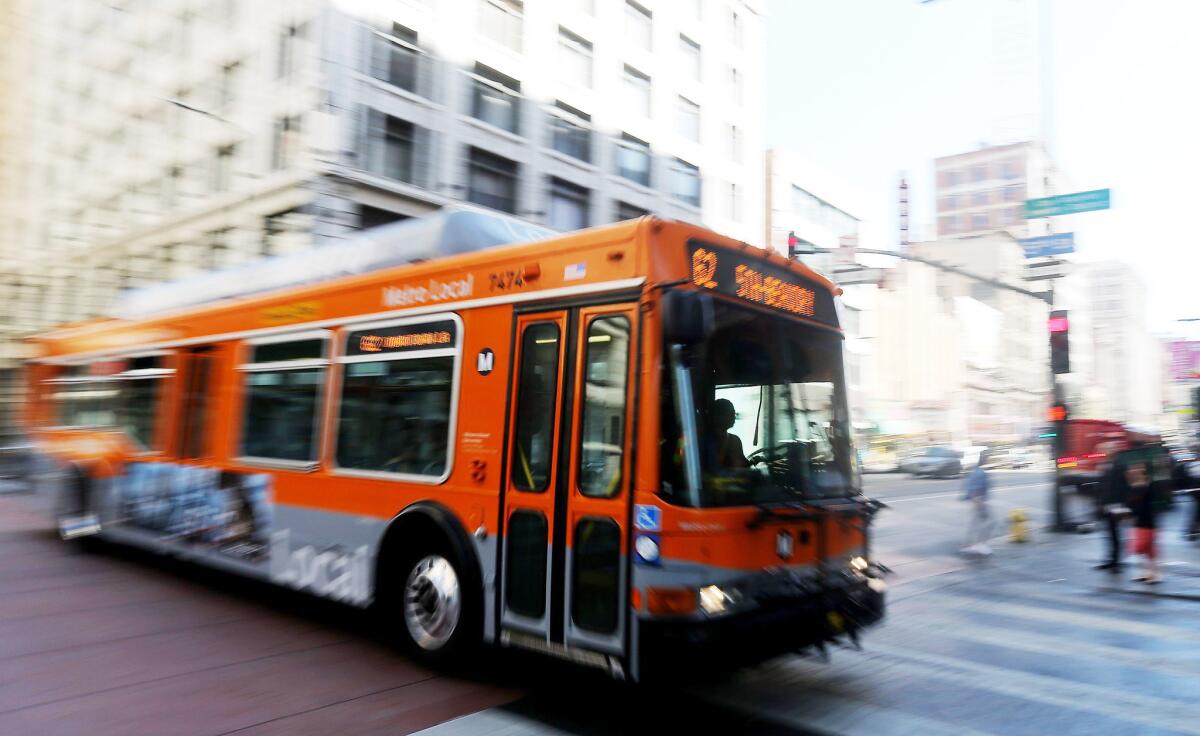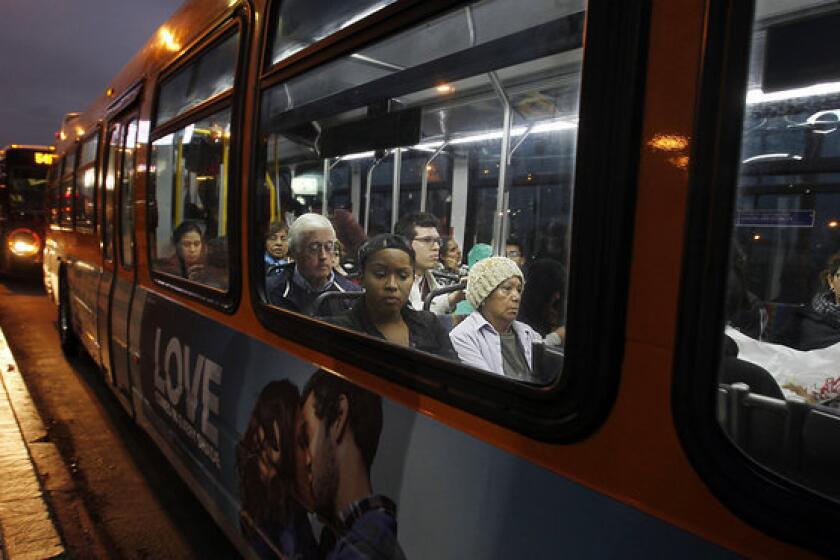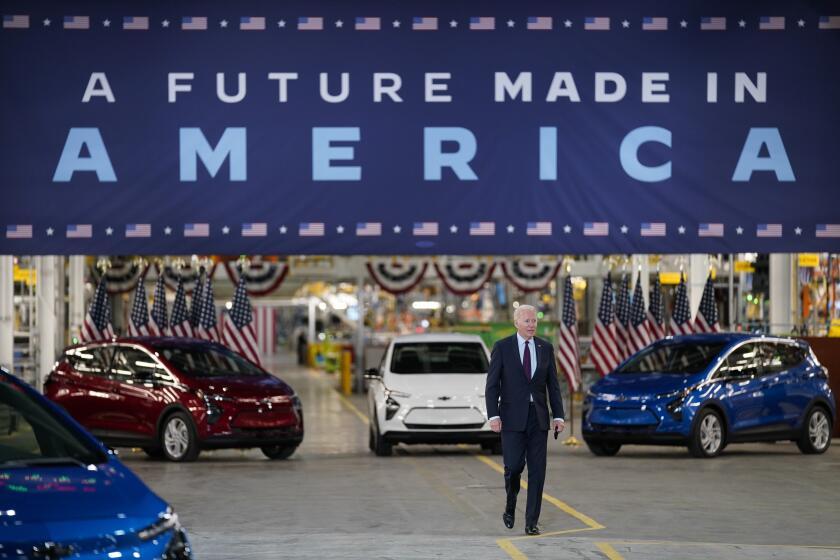Editorial: Finally, a bus-lane building boom in Los Angeles

The best advertisement for public transportation is seeing a bus whoosh past lines of cars stuck in traffic. When transit is convenient, comfortable, affordable and faster than driving, the service practically sells itself.
That’s why a recent bus-lane boom in Los Angeles is so welcome.
Since 2019, Metro and the city’s Department of Transportation have rolled out nine new segments for a total of 40 miles of bus lanes on some of the most congested streets with high bus ridership, such as La Brea Avenue, Venice Boulevard and Alvarado Street. The goal is to have 100 miles in place before the 2028 Olympics. Most are peak-hour, bus-only lanes, meaning they are open to other vehicles or parking outside of morning and afternoon rush hours.
If California wants people to drive less to cut planet-warming emissions, the state should be spending far more money on pedestrian, bike and transit projects.
The result has been faster, more reliable service for passengers — and maybe even a little bus envy for drivers stuck in traffic. Better bus service is essential to get people to jobs, schools and opportunities, and to entice drivers out of cars to help reduce planet warming emissions. So far, bus speeds have increased by as much as 30% and the lanes allow Metro to run buses more frequently, shaving precious time off riders’ commutes. (Speed and consistency will likely improve next year when Metro launches its automated camera enforcement program to photograph and fine drivers who park or drive in the bus lane during restricted hours.)
Perhaps most impressive is how quickly Metro and L.A. are getting these new lanes approved and installed in a year or less in some cases. That’s warp speed for transportation infrastructure. The Wilshire Boulevard bus lane, which was L.A.’s first and opened in 2015, took more than a decade to plan and build.
Metro has begun to roll out a new plan for speedier buses. But it will only work if there’s political will behind it.
What led to the transformation? Politics and process. Transit advocates have pressed Metro and elected officials to stop treating bus riders as an afterthought. Former Councilmember Mike Bonin, who also sat on Metro’s governing board, pushed for the creation of the Bus Speed and Reliability Working Group. With a clear goal — to speed up the buses — and a mandate from political leaders, staff at the two agencies were able to cut through bureaucratic barriers that often stymie public works projects.
Metro and the city have also managed to mostly avoid bus-lane NIMBYism that has plagued other efforts. Bus Rapid Transit, or busways, which operate like light rail lines with dedicated lanes and special stops, have faced resistance from some residents and business owners who worry about losing car lanes or parking. BRT projects have been dropped or scaled back in the north San Fernando Valley and Pasadena. So Metro and L.A. have taken the path of least resistance, installing most bus lanes on streets that already prohibit curbside parking during rush hours such as La Brea Avenue. Replacing a peak-hour traffic lane with a peak-hour bus lane has proven to be an easier sell than permanent lane removal. Plus, the projects are exempt from the California Environmental Quality Act, which reduces the amount of study needed for approval and the risk of lawsuits to block the lanes.
The trade off is that most bus riders get the benefit of bus lanes only during rush hours, which are typically 7 to 10 a.m. and 4 to 7 p.m. (At least one project, on Venice Boulevard, is a 24-hour bus lane.) Ideally, these peak-hour lanes will be such a convincing demonstration of the benefits of giving people fast, convenient bus service that L.A.’s political leaders will wholeheartedly support more dedicated busways and 24-hour bus lanes.
But there is a missing ingredient for success: enforcement. Drivers regularly park or block the bus lanes, particularly around coffee shops and other spots where people somehow think it’s OK to pull over and dash inside a shop. That forces bus drivers to merge into traffic to get around the vehicle, which slows the trip.
In a study from 2021, Metro found that a bus traveling on Wilshire Boulevard’s bus lane encountered cars blocking or driving in the lane an average of once every four minutes. As of now, the city’s limited pool of transportation officers are responsible for ticketing drivers who block bus lanes, which is not an effective deterrent.
General Motors’ agreement to include autoworkers in battery manufacturing shows climate action to electrify the economy doesn’t have to mean abandoning workers.
This month, Metro’s governing board is expected to approve a contract for automated license plate readers cameras on buses to catch lane blockers. Metro can’t issue tickets, so it will share the photographs with the city, which can issue fines of up to $293 after a period of warnings and driver education.
Los Angeles’ buses are the workhouses of the region’s transit system. But for too long, they haven’t been given preferential treatment and riders noticed; there was a 25% drop in bus trips in the years before the pandemic and ridership is still below 2019 levels. The bus-lane building boom is a good start toward delivering the quality bus service riders deserve and the region needs.
More to Read
A cure for the common opinion
Get thought-provoking perspectives with our weekly newsletter.
You may occasionally receive promotional content from the Los Angeles Times.













